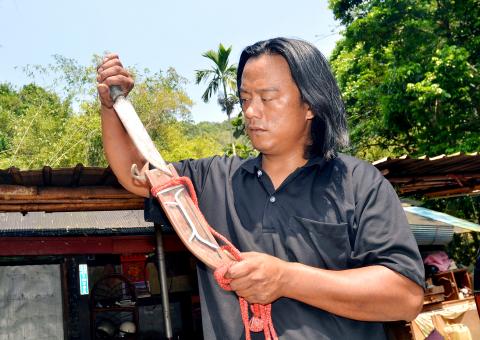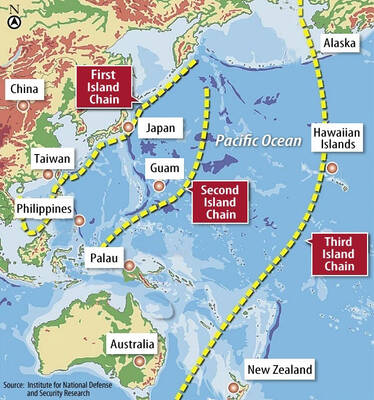Aboriginal knife maker Lee Chang Li-yuan (李張力元) is adamant that buyers of his knives take his course on how to use them.
“These knives aren’t sold lightly, and they are not for looking cool. Once you enter the mountains and woods, nature teaches you their uses,” Lee Chang said, adding that every knife a Rukai tribesman holds has a story of its own.
Lee Chang, 36, served in the army for a decade before returning to his home village seven years ago and starting to make knives the traditional way.

Photo: CNA
Due to his beliefs, Lee Chang insists that any buyer has to participate in about 248 hours of training, which includes meeting Rukai tribesmen, learning about the tribe’s rituals and ceremonies regarding the uses of the knives, and in Lee Chang’s words, “getting acquainted with your weapon.”
The 248 hours of training is a rough estimate, and buyers do not necessarily have to stay that long, but they do have to meet a certain standard before they are entitled to own the knives, Lee Chang said.
According to Lee Chang, every Rukai tribesman has traditionally owned five knives over the course of their life. The first is a small knife parents place under the pillow of a child, to ward off spirits and calm the infant. The second — known as a working knife — is given to a boy when he reaches the age of 13 or 14 and begins to participate in tribal affairs and learn how to be a man.
Receiving the working knife symbolizes the beginning of the learning process, Lee Chang said, adding that of all the knives a Rukai owns, the “working knife” has the widest application.
The Rukai use it in everyday life, for chopping wood in the mountains, or for hacking a trail when traveling through rough terrain, Lee Chang said, adding that it was an extension of the user’s hand.
Without a working knife a man would find himself almost completely unable to move in the mountains, and would feel like a cripple when out of the mountains, Lee Chang said.
The third knife is the hunting knife, Lee Chang said, adding that the blade of a hunting knife is shorter than that of a working knife, making it very useful for close quarters combat and hunting.
The hunting knife can also be tied to the end of a bamboo pole, turning it into a spear and making it effective against boars, Lee Chang said, adding that he had used his own hunting knife to kill six boars.
The fourth knife — the ceremonial knife — is the most ornate, and is usually hung on the walls of the house and not worn except during ceremonies, Lee Chang said, adding that only those with grandchildren were worthy of such blades.
The ceremonial knife symbolizes the continuation of tribal life, and was a “blade of life,” Lee Chang said.
However, the ceremonial knife used to have another use — to sever the heads of enemies, Lee Chang said, adding that in the old days, only chieftains or elders could wear the ceremonial knife without being ridiculed.
The last knife is not a knife of steel, but of teeth, Lee Chang said, adding that as one ages, a person loses teeth and returns to a stage akin to infancy.
Rukai elders always carry with them a small knife made from their own teeth, with which to carve meat, Lee Chang said.
“Our ancestors did not leave us any relics, they only gave us the land,” Lee Chang said.
In light of this, Lee Chang and other Aborigines have worked hard in recent years to rebuild old tribal villages and promote their unique lifestyles as a tourist attraction.
Lee Chang said that in modern times the knife serves not as a weapon with which to take another’s life, but as a key between the Aborigines and their ancestral mountains.
Lee Chang said he hoped the knife would “open the way for younger Rukai to once again be connected to the land of our ancestors.”

An alleged US government plan to encourage Taiwan Semiconductor Manufacturing Co (TSMC) to form a joint venture with Intel to boost US chipmaking would place the Taiwanese foundry giant in a more disadvantageous position than proposed tariffs on imported chips, a semiconductor expert said yesterday. If TSMC forms a joint venture with its US rival, it faces the risk of technology outflow, said Liu Pei-chen (劉佩真), a researcher at the Taiwan Industry Economics Database of the Taiwan Institute of Economic Research. A report by international financial services firm Baird said that Asia semiconductor supply chain talks suggest that the US government would

WANG RELEASED: A police investigation showed that an organized crime group allegedly taught their clients how to pretend to be sick during medical exams Actor Darren Wang (王大陸) and 11 others were released on bail yesterday, after being questioned for allegedly dodging compulsory military service or forging documents to help others avoid serving. Wang, 33, was catapulted into stardom for his role in the coming-of-age film Our Times (我的少女時代). Lately, he has been focusing on developing his entertainment career in China. The New Taipei District Prosecutors’ Office last month began investigating an organized crime group that is allegedly helping men dodge compulsory military service using falsified documents. Police in New Taipei City Yonghe Precinct at the end of last month arrested the main suspect,

Starlux Airlines on Tuesday announced it is to launch new direct flights from Taiwan Taoyuan International Airport to Ontario, California, on June 2. The carrier said it plans to deploy the new-generation Airbus A350 on the Taipei-Ontario route. The Airbus A350 features a total of 306 seats, including four in first class, 26 in business class, 36 in premium economy and 240 in economy. According to Starlux’s initial schedule, four flights would run between Taoyuan and Ontario per week: Monday, Wednesday, Friday and Saturday. Flights are to depart from Taoyuan at 8:05pm and arrive in California at 5:05pm (local time), while return flights

LITTORAL REGIMENTS: The US Marine Corps is transitioning to an ‘island hopping’ strategy to counterattack Beijing’s area denial strategy The US Marine Corps (USMC) has introduced new anti-drone systems to bolster air defense in the Pacific island chain amid growing Chinese military influence in the region, The Telegraph reported on Sunday. The new Marine Air Defense Integrated System (MADIS) Mk 1 is being developed to counter “the growing menace of unmanned aerial systems,” it cited the Marine Corps as saying. China has constructed a powerful defense mechanism in the Pacific Ocean west of the first island chain by deploying weapons such as rockets, submarines and anti-ship missiles — which is part of its anti-access/area denial (A2/AD) strategy against adversaries — the